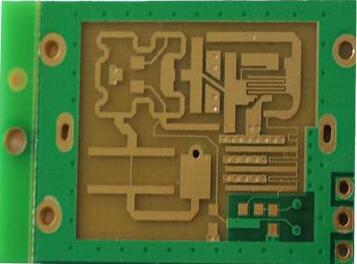The copper wire of the PCB Rogers high-frequency microwave and radio frequency board is bad (also commonly referred to as dumping copper). PCB Rogers high-frequency microwave and radio frequency board factories all say that it is a laminate problem, and its PCB Rogers high-frequency microwave and radio frequency board production plants are required to bear the bad loss. According to customer complaint handling experience, the common reasons why PCB Rogers High Frequency Microwave RF Board Factory reject copper are as follows:
1.PCB Rogers High Frequency Microwave RF Board Factory Process Factors
1. The copper foil is over-etched. The electrolytic copper foil used in the market is generally single-sided galvanized (commonly known as ashing foil) and single-sided copper plating (commonly known as red foil). The common thrown copper is generally galvanized copper above 70um. Foil, red foil and ash foil below 18um basically have no batch copper rejection.
When the PCB Rogers high frequency microwave radio frequency board is better than the etching line, if the copper foil specification is changed and the etching parameters remain unchanged, the residence time of the copper foil in the etching solution is too long. Because zinc is originally a lively metal, when the copper wire on the wireless communication PCB Rogers high-frequency microwave radio frequency board is immersed in the etching solution for a long time, it will inevitably lead to excessive side corrosion of the line, resulting in the complete backing of some thin lines. It reacts and detaches from the substrate, that is, the copper wire falls off.
Another situation is that the etching parameters of the PCB Rogers high-frequency microwave radio frequency board are not problematic, but after the etching, the copper wire is also surrounded by the residual etching liquid on the surface of the PCB Rogers high-frequency microwave radio frequency board. Untreated, it will also produce excessive copper wire side corrosion and dump copper. This situation is generally manifested as concentrated on thin lines, or during periods of wet weather, similar defects will appear on the entire PCB Rogers high-frequency microwave radio frequency board. Strip the copper wire to see the contact surface with the base layer (the so-called roughening Surface) The color has changed and is different from the normal copper foil color. What you see is the original copper color of the bottom layer, and the peeling strength of the copper foil at the thick line is also normal.
2. The design of wireless communication PCB Rogers high frequency microwave radio frequency board is unreasonable, and the design of too thin lines with thick copper foil will also cause excessive etching of the lines and copper rejection.
3. In the wireless communication PCB Rogers high frequency microwave radio frequency board process, a local collision occurred, and the copper wire was separated from the base material by external mechanical force. This poor performance is poor positioning or orientation, the copper wire will be obviously twisted, or scratches/impact marks in the same direction. If you peel off the copper wire at the defective part and look at the rough surface of the copper foil, you can see that the color of the rough surface of the copper foil is normal, there will be no side erosion, and the peeling strength of the copper foil is normal.

2, the reason for the laminate process
Under normal circumstances, the copper foil and the prepreg will be basically completely bonded as long as the high temperature section of the laminate is hot pressed for more than 30 minutes, so the pressing will generally not affect the bonding force of the copper foil and the substrate in the laminate. However, during the process of stacking and stacking laminates, if the PP is contaminated or the matte surface of the copper foil is damaged, the bonding force between the copper foil and the substrate after lamination will also be insufficient, resulting in positioning (only for large plates) Words) or sporadic copper wires fall off, but the peel strength of the copper foil near the disconnected wires will not be abnormal.
3. Reasons for laminate raw materials
1. It is mentioned on the wireless communication PCB Rogers high frequency microwave radio frequency board that ordinary electrolytic copper foil is a product that has been galvanized or copper-plated. Poor plating crystal branches result in insufficient peel strength of the copper foil itself. When the poor foil pressed sheet material is made into PCBPCB Rogers high-frequency microwave radio frequency board, when it is plug-in in the electronics factory, the copper wire will fall off under the impact of external force. This type of copper rejection is not good. If you peel off the copper wire and see the rough surface of the copper foil (that is, the surface in contact with the substrate), there will be no obvious side erosion, but the peel strength of the entire copper foil will be very poor.
2. Wireless communication PCB Rogers high frequency microwave radio frequency board copper foil and resin have poor adaptability: some special performance laminates, such as HTg sheets, are used now, because the resin system is different, the curing agent used is generally PN resin, The resin molecular chain structure is simple, and the degree of cross-linking is low during curing, so it is necessary to use copper foil with a special peak to match it. When producing laminates, the use of copper foil does not match the resin system, resulting in insufficient peeling strength of the sheet metal-clad metal foil, and poor copper wire shedding when inserting.